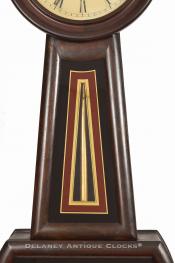E. Howard & Co. No. 1 Regulator wall clock. 221181.
This very impressive wall timepiece regulator is the E. Howard Clock Company's Model Number 1. This model was originally marketed as a regulator for watchmakers who used this timepiece to time or regulate the watches they repaired. This model was also advertised as being "Well adapted for banks, insurance offices, and large rooms."
The E. Howard & Company offered five graduating sizes of this popular banjo form. This example is the largest of the five sizes measuring 4 feet 2 inches long and having a dial that is 12 inches in diameter. For comparison, the smallest example measures 29 inches in length and is called the Model Number 5.
Traditionally, Howard banjo cases are constructed in cherry and are finished with a faux grain pattern executed in India ink. This process simulates rosewood's rich natural grain pattern. The grain pattern exhibited on the outside facing surfaces of this example is in good original condition. Unfortunately, the original surface has darkened with age, and the graining is now difficult to see. The finish has turned brown and is consistent. It has an old-world appearance. The frames are fitted with restored reverse painted tablets or glasses. The colors black, gold and red are the traditional Howard color combinations. The painted iron dial measures 12 inches in diameter. It is protected by glass that is fitted into the case bezel. This dial is signed in block lettering by the Clockmaker. It reads, "E. Howard & Co. / BOSTON.” Again, this model, the largest size, features a subsidiary seconds dial in the time track. The other four Howard banjo models do not. The weight-driven movement is constructed in brass and is of excellent quality. The long rectangular-shaped movement plates are robust. The Maker's name is die-stamped into the front plate. The backplate is secured to the backboard with four brass tabs. The movement is designed to run for eight days on a full winding. It features weight power, a Graham Dead Beat Escapement, a Geneva Stop winding mechanism (which will be restored), and maintaining or retaining power gearing. The original weight is cast in iron. The gilded cherry wood pendulum rod is supported by a bridge that is mounted on the front of the movement. The suspension features two springs that are mounted in brass blocks. The rod can be seen through the clear opening in the waist glass. The brass-covered bob measures 8 inches in diameter. It is decorated with four concentric engraved rings. Alternate rings are decorated with a damascene design. The bob can be seen through the clear opening in the lower tablet or glass.
This clock was made circa 1870 and is a good example. This model has proven to be a very accurate timekeeper.
Inventory number 221181.
The E. Howard & Company succeeded the Howard & Davis firm in 1857. The Howard & Davis firm was comprised of Edward Howard and David Porter Davis and was established in 1842 in Roxbury, Massachusetts. Both men had just completed their clock apprenticeship under the guidance of Aaron Willard Jr in Boston. The Howard & Davis firm made high-grade clocks, precision balances, sewing machines, fire engines, and watches. After the dissolution of Howard & Davis, Edward Howard became Boston's leading manufacturer of weight-driven residential and commercial clocks. The firm also made a large number of tower clocks and watchman and salve clock systems. These sold well in the last quarter of the 1800s.
It has been said that the E. Howard Clock company never made an inexpensive clock, and everything they made was of very good quality. As a result, Howard clocks have become very collectible and are prized by their owners. Today, the E. Howard name enjoys outstanding name recognition.
For a more in-depth reading of Edward Howard and his various businesses, please read "Willard's Patent Time Pieces," written by Paul Foley.
















